Hi Kim! Your cross from Minutifolia looks pretty and healthy. Perhaps you could cross Crested Abundance with Minutifolia. Something might come out of that.
Two great minds flowing down the same gutter…I already made that cross last month, John. Thanks! I hope the sepals enhance each other.
That has to be the hardest thing you have accomplished so far this century.
Now what? I have to say the hybrids really don’t look like the species which is unusual for species crosses. It makes me wonder about which traits have made it into the hybrid from the species, perhaps only a smidgen or, maybe, there is lots of heterogeneity lurking within minutifolia that got locked up as it became geographically isolated.
Perhaps these hybrids can bridge back to the species to see if you can capture more of the unique foliage that is the outstanding morphological feature of minutifolia.
Thanks, Don. But, look at the first generation Hulthemia hybrids. They didn’t look Hulthemia, either. All had larger, compound foliage of colors other than the species. I have also made crosses of Otay Mesa Minutifolia and Pure Bea, the white variation, back on the L56-1 X Minutifolia seedlings. I’ve done the same with the L56-1 X Puzzlement, putting Puzzlement back on its seedling, in hopes of bringing more of the species out in the hybrids. Probably the only way to maintain the miniature nature of the foliage is to use micro minis. Even then, I’d expect the foliage to be larger due to F1 vigor. I’ve also pollinated Stellata mirifica with the two Minutifolia pollens as well as Golden Angel and Tom Thumb pollens. Stellata and Minutifolia are Hesperhodos, so they SHOULD be compatible.
I’ve also pollinated Stellata mirifica with the two Minutifolia pollens
Boldly going where no one has gone before - I’m gonna start calling you Kirk.
I’d expect the foliage to be larger due to F1 vigor.
I have had enough F1’s belly up in the pond to know that the concept of hybrid vigor is Burbankian hyperbole. I think if you were to generate many, many F1 seedlings some will turn up with largish minutifolia type leaves. A project for next century, perhaps.
“I have had enough F1’s belly up in the pond to know that the concept of hybrid vigor is Burbankian hyperbole. I think if you were to generate many, many F1 seedlings some will turn up with largish minutifolia type leaves. A project for next century, perhaps.”
I’m sure you have, and perhaps not all F1 seedlings fit, but I’ve seen many which have. Ralph Moore raised many FI moss hybrids which were enormous, multiples larger than either parent. 12-59-10, his Pinocchio X William Lobb, grew much taller than his green houses '12-59-10' Rose. He kept it pruned off at the top of the house by which it grew. There were a number of other moss hybrids of similar size and vigor in another area of the nursery whose identities had been lost over time. I hope you’re right that more seedlings may result in some with Minutifolia foliage. I have collected every bloom from both types for the past year and used it all on anything that moves! I thought selfs could help, particularly after raising 1-72-1Hugonis flore plena '1-72-1Hugonis flore plena' Rose provided me with almost what I was trying to create. I hope GAX1-72-1Hugonis sets selfs (almost all have fallen off) 'GAX1-72-1Hugonis' Rose as it has given a scattering of later blooms after the main flush.
These seedlings are really amazing. It does look like the Minutifolia did exert quite an influence on the self seedling of L56-1 X Minutifolia with the very tight rounded leaf structure and even more so with the Lynnie x Minutifolia where the leaf looks very rigid and shows all those tiny prickles. But, these are certainly a huge step in a direction away from Minutifolia. It will be even more interesting to see if they are as heat, sun and drought tolerant (or carry a little bit of those characteristics) as Minutifolia.
Thanks, Jackie. Ironically, Minutifolia isn’t that “heat tolerant”. It does significantly better in filtered inland and beach sun and flowers most of the year when protected from the extremes. In the San Fernando Valley, I had to grow it behind larger HT bushes due to the intensity of the heat and UV. In the old Newhall garden, it grew best where it received morning light and protection from the larger plants during the hotter periods. Here, where it’s twenty-plus degrees cooler, the UV is even more extreme and it demands filtered sun through the trees or the leaves fry. “In the wild”, it gets fogs and heavy dews and then drops the foliage when the ground water dries up. It tries that when it’s hot in Encino and here, but will resist it if provided more protection against the extremes. I had also expected Stellata mirifica to be more “heat tolerant”, but was warned when friends brought the current plant to protect it against the hottest sun and keep it well watered. It shared the same conditions in Newhall and most of its life in Encino, until I mistakenly planted it out on the western, dry, hot, exposed hill where no amount of water could prevent it from dying. I had that plant for twenty years and it was the direct sun and heat that killed it. The new one, receiving only morning sun and being watered with all the other pots, has lovely foliage (except for the blamed spider mites which adore this climate) and has produced six flowers from the tree gallon plant.
Mine is along a very relflective concrete driveway with all day sun (but a little filtered in the early AM from the very open leaf form of Lady Hillingdon right next to it; nothing protects it from the very hot afternoon sun) and it is still in a black pot. The only times it has gone semi dormant is when I refrain from watering it somewhat in the mid-summer. I live about 3 miles from Otay Mesa where this plant originates, and we get no morning mists or dew here in the summer. Sometimes, including this yr., we will have a short spate of “May Grey” which denotes a particular weather pattern with some morning fog–nothing like Monterey penninsula, but rather a delayed AM hot sun for anywhere from a few days to a few weeks. This does not continue into the summer when it is very hot, and we did not get this pattern the past two years. I am just using one plant as the basis for this judgement, but if they come from Otay Mesa, there is nothing there to protect them. My plant also takes a lot of wind, which it does not seem to mind at all, which I would expect as the winds on the mesa are even stronger. I have refrained from planting my Minutifolia out because of the heavy gopher problem we have, being between open lots at the upper end of a canyon. So just based on the observations of this one plant, and knowing its’ source in nature, I would expect it to pass on a certain sun and heat resistance. Or at least hope it would, without it having to go totally dormant if it was supplied with a little regular water.
Interesting. I had three in five gallon nursery cans for the past nearly twelve years. I lost one a few months ago. The second is off color but full of foliage. The third looks just fine and is flowering. Those two are against the wooden fence on the west side of the yard where they get mid day sun and afternoon shade. The Mexican, Pure Bea and UC Berkeley Big Pink types are also canned and get more filtered light and those three are much “happier” looking.
Buds have opened! Lynnie X Minutifolia.
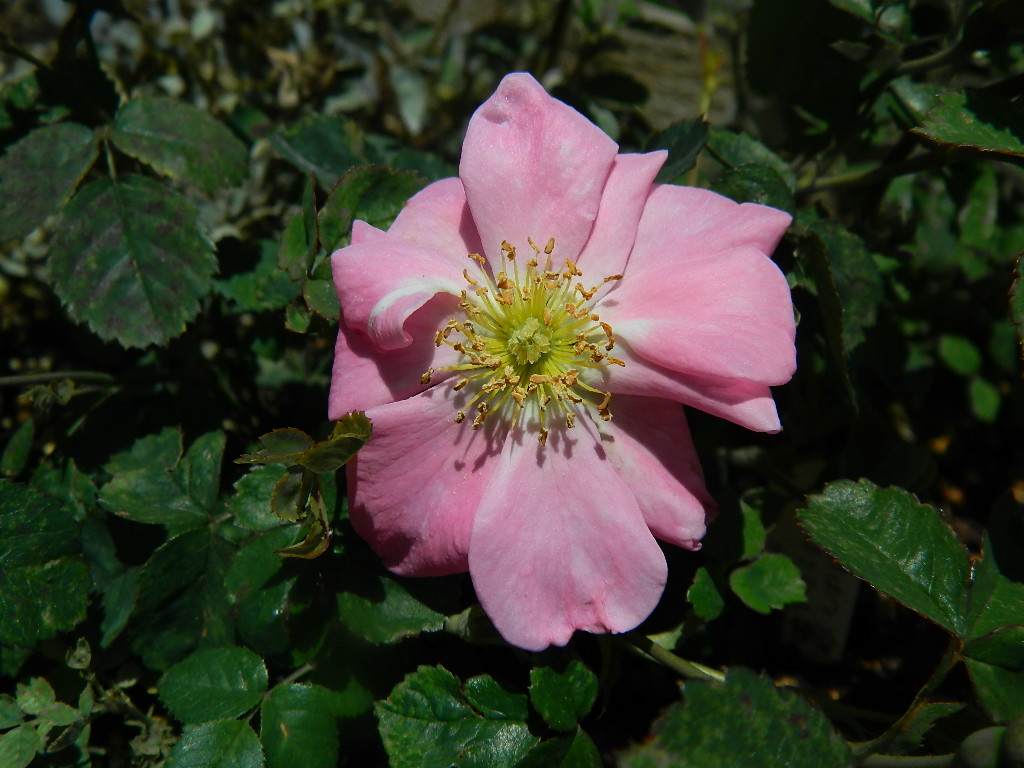
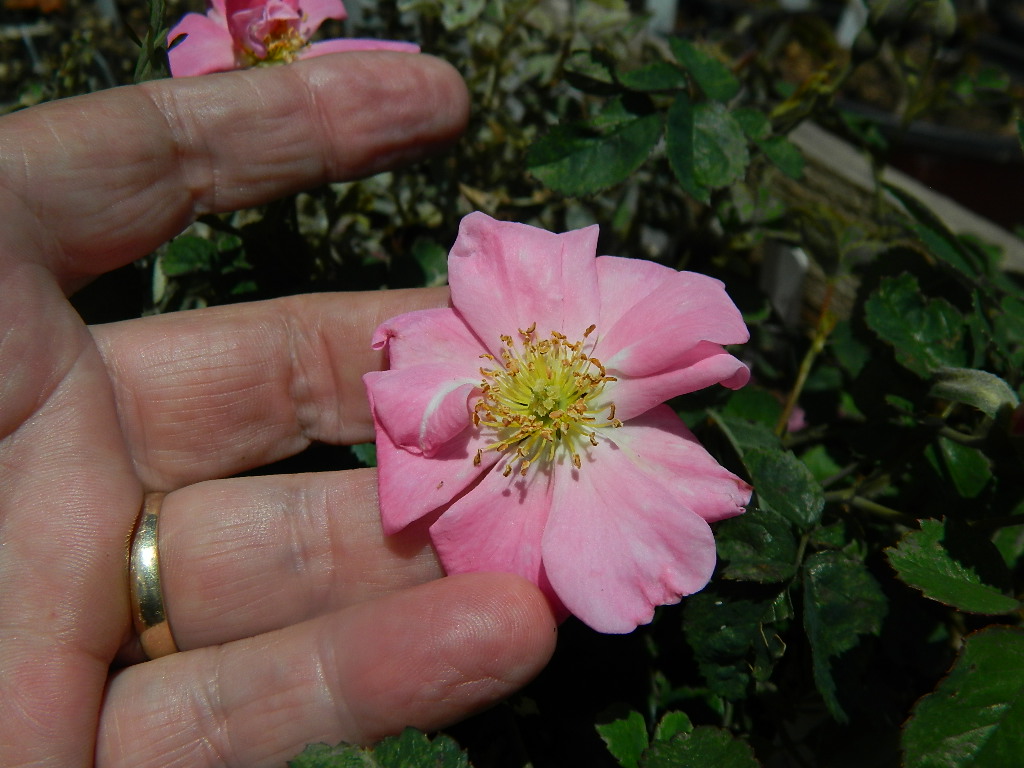

L56-1 X Minutifolia self seedlings, two different ones.

Notice the Minutifolia “hairs” on the sepals.
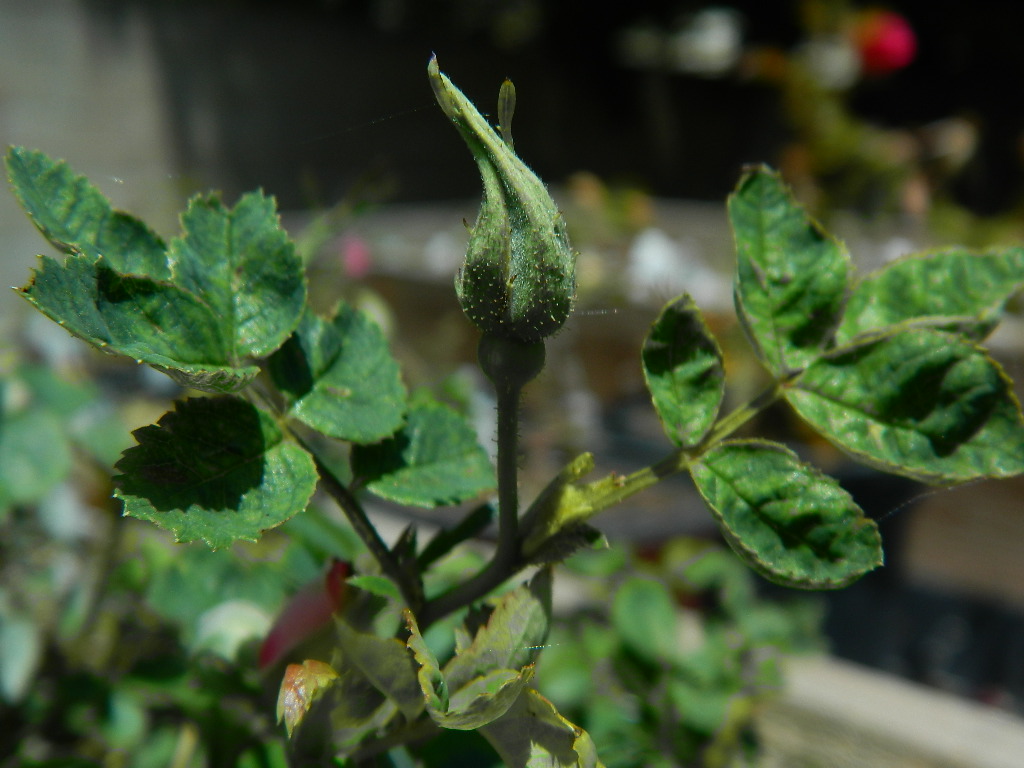
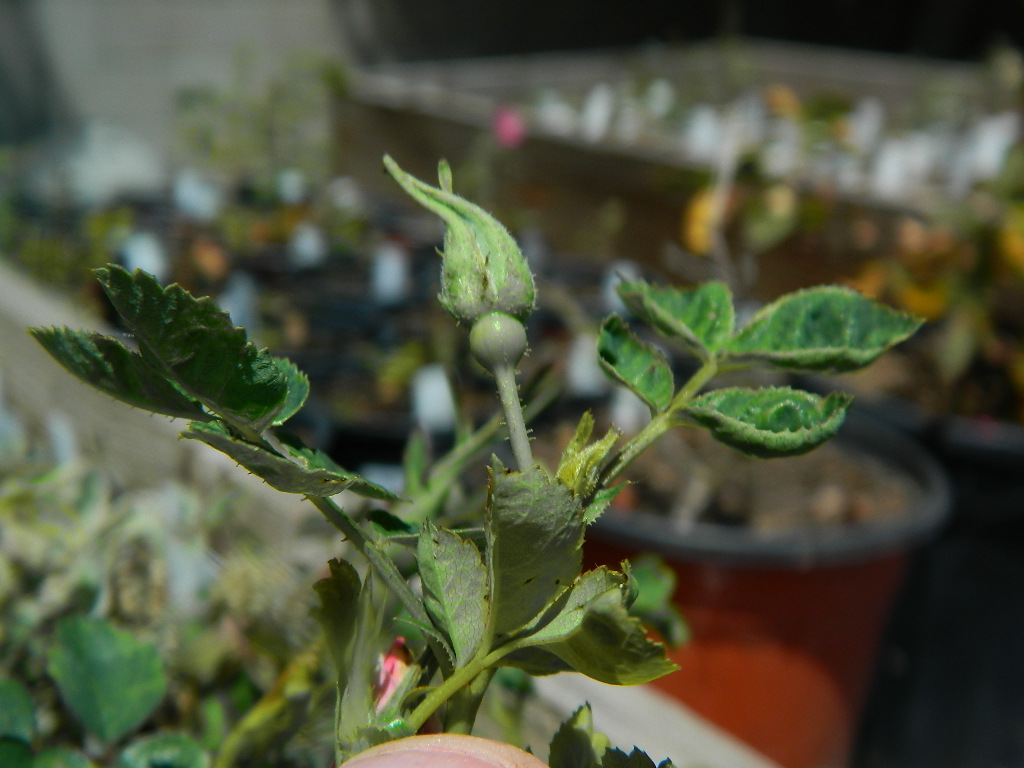

Excellent.
So do these require watering by Tule fog?
They do get fogs and heavy dews, but also heavy hose soakings. I wish they could exist on what they receive “naturally”!
Really nice there Kim.
Thank you, Rob!
Hybrid vigor is common enough. Long ago I read a paper on sylviculture. The author(s) raised F1 species hybrids of various tree (I recall maple, oak, maybe elms, among others). They reported an average increase in vigor of about 30%. That’s not so great as Burbank’s hybrid walnut that had annual rings nearly an inch thick, but still pretty good.
Swingle and Webber (1897) raised a wide assortment of Citrus hybrids. Those between the Trifoliate orange and the common orange were called Citranges. Swingle (1927) wrote, “Almost all of the citranges grow faster than the combined growth of both parent species.” No hyperbole required.
One of the difficulties in studying hybrid vigor has been the fact that it is not a single phenomenon. One involves different means to similar ends, and the other is adaptedness.
Bateson (1909) described three classes of garden peas: dwarf, half-dwarf and tall. Two of his students, Keeble and Pellew (1910) saw that the half-dwarf group contained two very different types. One resembles the tall types in all things, but has shorter internodes. The other has narrower leaflets, thinner stems and reduced branching (like the dwarf types), but with longer internodes.
By crossing specimens of the two types of half-dwarf peas, K&P raised a group of tall plants. The F2 generation segregated as tall, dwarf and the two types of half-dwarf.
The tall crossbred plants are not examples of hybrid vigor. But this case can serve as a template for some real cases.
Tree Physiology, 24:217–224
Phytohormones and shoot growth in a three-generation hybrid poplar family
David W. Pearce, Stewart B. Rood and Rongling Wu
The F1 hybrids displayed heterosis (hybrid vigor) for primary growth as a result of the complementation of dominance for increased internode length from the P. trichocarpa parent and dominance for increased diameter from the P. deltoides parent.
Anderson (1944) described introgression of Tradescantia subaspera var. typica and T. canaliculata. These species grow to about the same height. However, canaliculata has longer internodes, while the other has more nodes. Thus, it is not too surprising to find hybrid plants about double the size of the parents.
http://bulbnrose.x10.mx/Heredity/Anderson/AndersonInternodes1944/AndersonInternodes1944.html
It is worth noting that modern Corn Belt corn is derived from hybrids of Northern Flints (few, long internodes) and Southern Dents (many more nodes).
Adaptedness is also an important aspect of hybrid superiority. And again, the modern U.S. Corn Belt is between the regions where the NORTHERN Flints and SOUTHERN Dents are at their best.
Plants have their preferred temperature for growth.
Greeley: Temperature and Rose Bloom (1919)
http://bulbnrose.x10.mx/Roses/breeding/Greeley1919/Greeley1919.html
Greeley: Night-Growth of Roses (1920)
http://bulbnrose.x10.mx/Roses/breeding/GreeleyNightGrowth/GreeleyNightGrowth.html
Suppose one parent grows best in heat, while the other favors cooler temperatures. The offspring may enjoy suitable temperatures over a longer period each day, and over a longer season.
For example, ‘Marechal Niel’ loves heat, while ‘Golden Showers’ favors mild temperatures. The latter does beautifully in San Jose, CA, but was next to worthless in Kansas, because it simply stopped growing in the heat of summer. This is one of the projects I never got around to trying.
I read a statement of considerable interest, but misplaced it. The gist was that wood of a hybrid tree did not differ noticeably from wood of the parent trees growing under optimum conditions. The “trick” is that the hybrids (of properly selected parents) can find a broader range of conditions to be optimum.
Karl
I am having some fun with R.Minutifolia also-at least with a 25% minutifolia. I have gotten a bit tired of pink and am trying to go straight to another color.
this seems to work well with minutifolia. The full pedigree is{( DorolaxJulia Child) X [(Mme BraveyxRte66)x(MoondancexMidas Touch)] X R.minutifolia)}. The plant is spotless in a sea of spots. It also has more than its’ share of needle like bristles. Looking forward to seeing how a little maturity treats the flower size and shape. Just had the photo of the plant, leaves, etc deleted-will try to figure that one out.
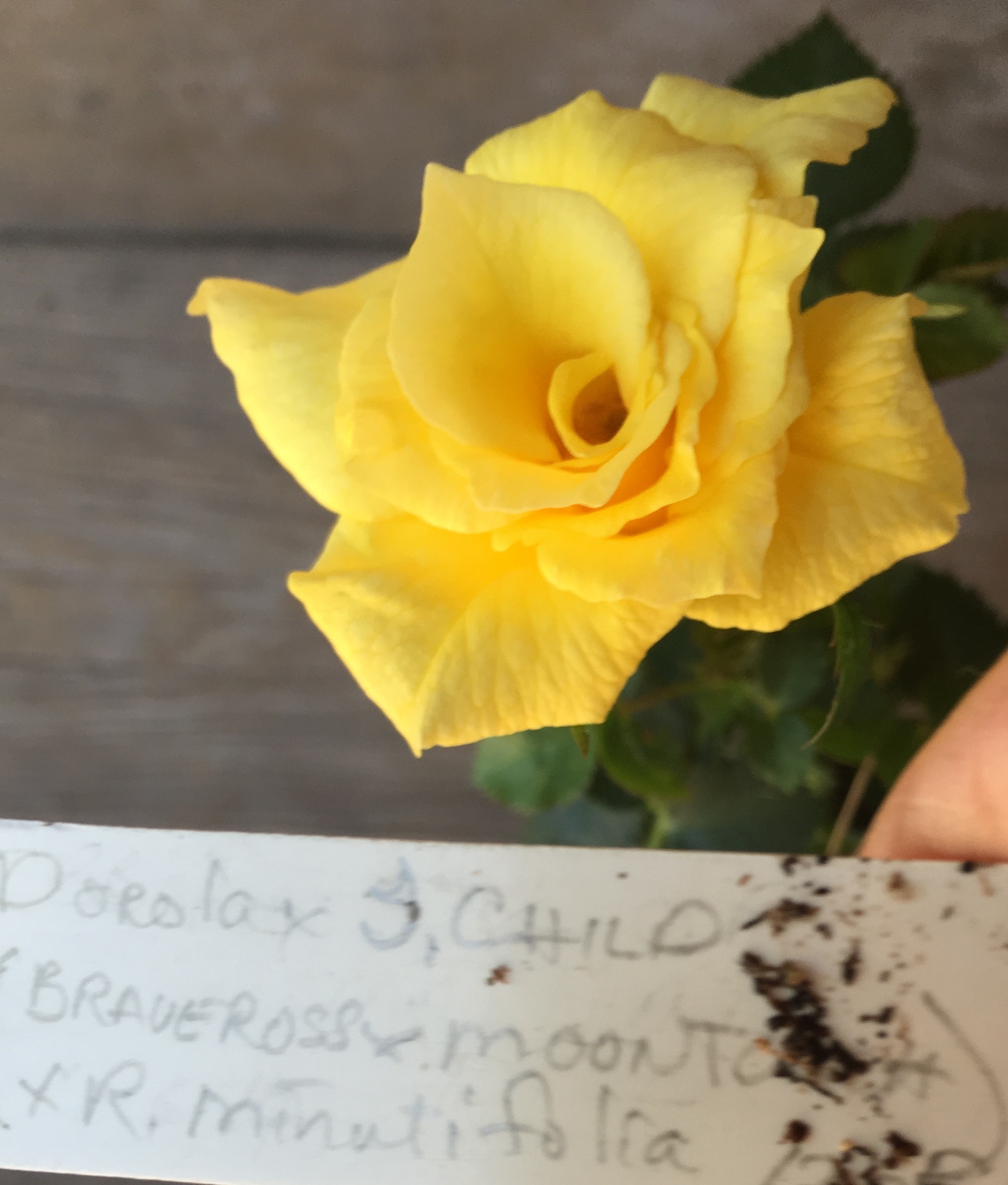
I love how healthy these few half and quarter minutifolias that I have are growing. This is the leaf and body shot of the prior seedlings photo with its’ flower. It is a good year for spots thus far for many seedlings. Tomorrow I will check on that I.D., because if memory serves me right the Dorola x J.Child was really (DorolaxBaseysLegacy) X Julia Child. Just more to remember, more to write, etc.
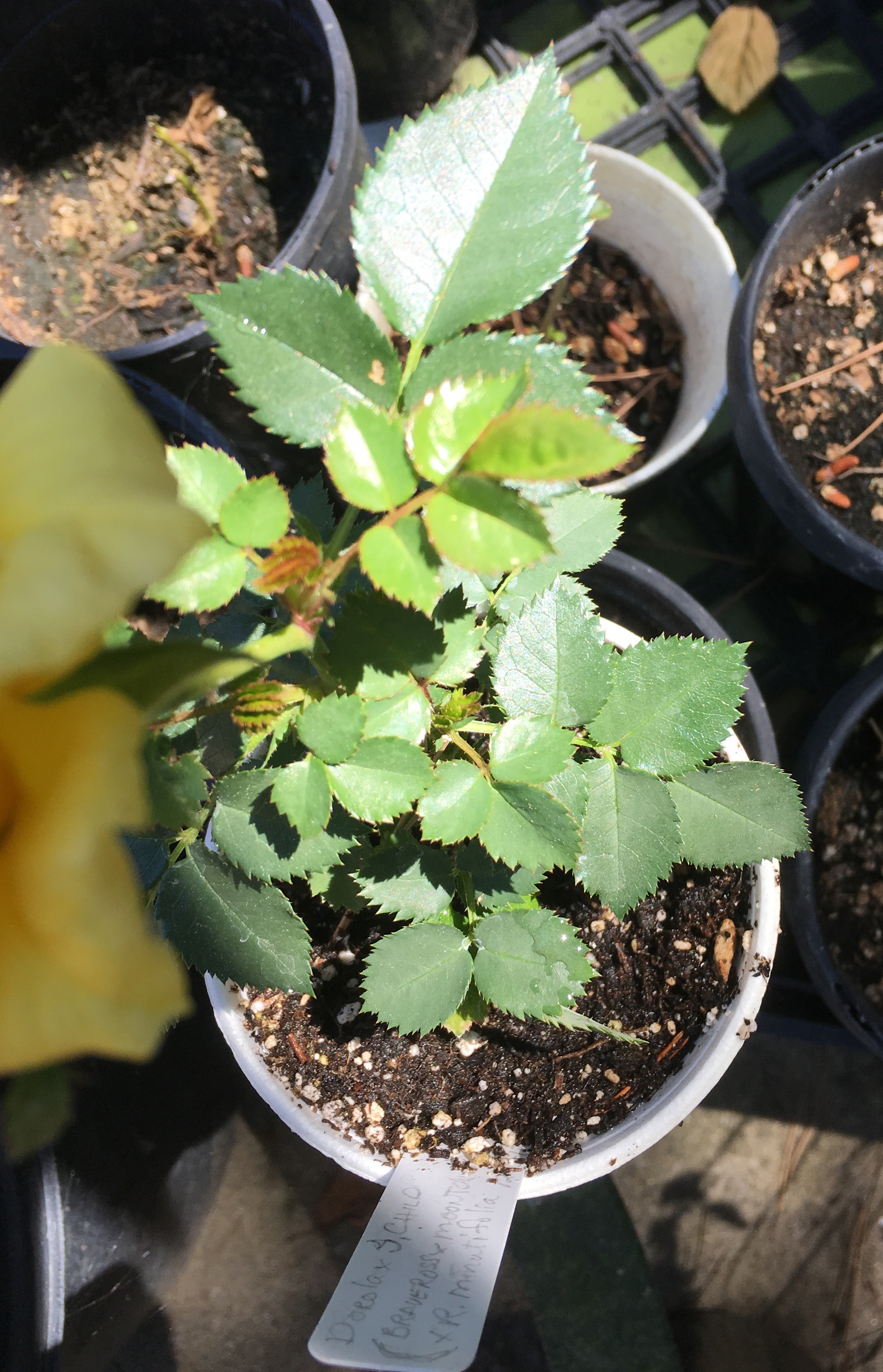
Quite nice, Jackie, congratulations!